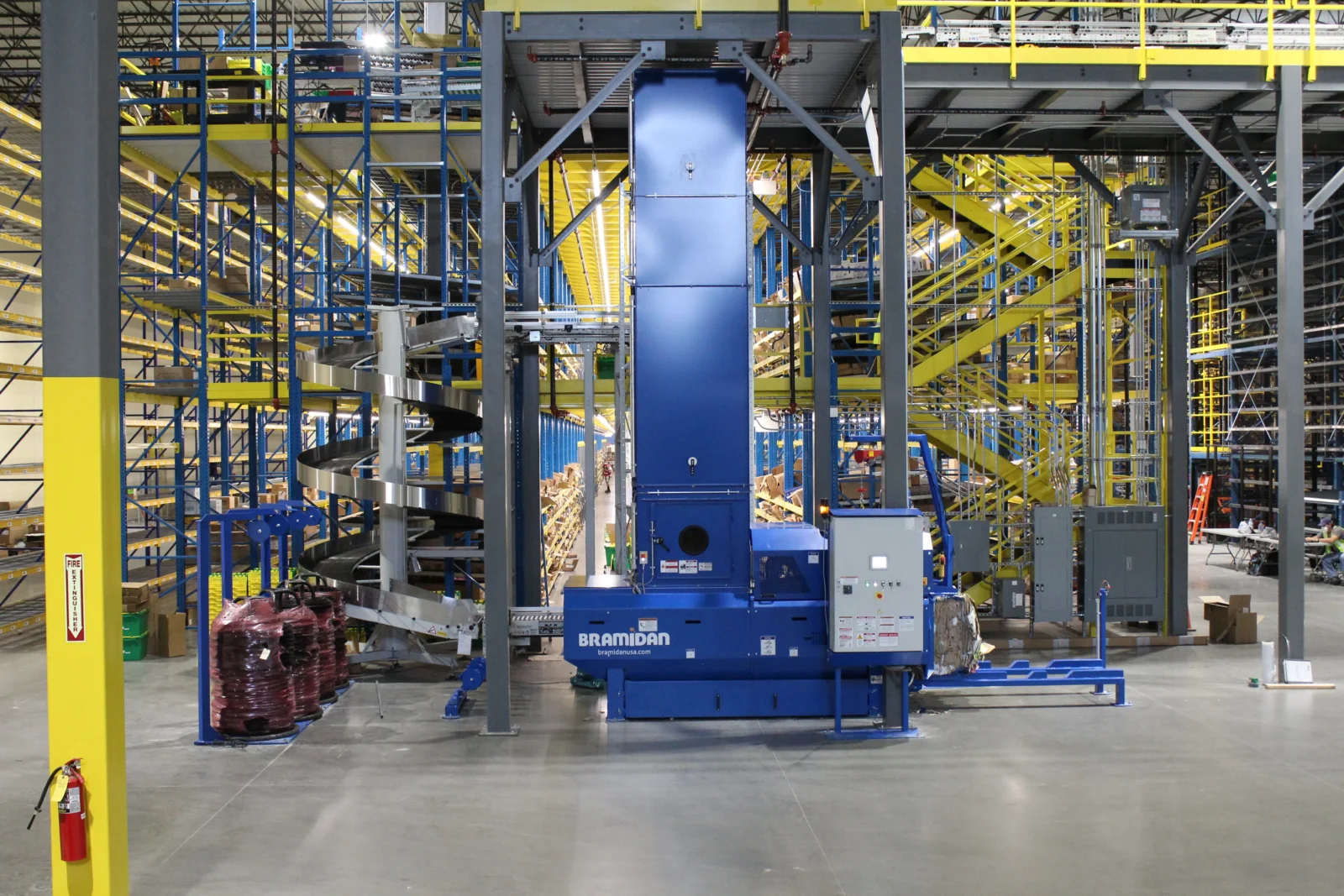
For modern distribution centers, waste management isn’t just an operational concern—it’s a strategic one. With the rise in e-commerce and rapid shipping demands, facilities now handle thousands of packages a day. That volume creates a massive stream of waste, primarily in the form of general trash and recyclables like cardboard and plastic wrap.
To manage this waste effectively, two types of equipment dominate the conversation: compactors and balers. Choosing between them—or understanding how to combine them strategically—can significantly improve your waste handling process, reduce costs, and advance your company’s sustainability goals.
In this guide, we’ll break down the differences between compactors and balers, their individual advantages, and how to evaluate which solution (or combination) is best for your distribution center’s specific waste profile.
The Waste Management Challenge in Distribution Centers
Distribution centers are high-throughput environments where efficiency is paramount. Yet waste accumulation can slow down operations, clutter workspaces, and increase hauling costs. More importantly, ineffective waste handling can lead to non-compliance with environmental regulations and missed opportunities for recycling rebates.
A key challenge lies in separating general waste from recyclable materials. Often, both types are generated simultaneously. If not managed correctly, recyclables become contaminated and must be landfilled—adding cost and undermining sustainability efforts.
This is where the right waste equipment becomes critical. Compactors and balers serve different waste streams and operational needs. Selecting the wrong equipment—or overlooking the need for both—can result in inefficiencies, unnecessary costs, and underperformance against ESG metrics.
What is a Compactor?
A waste compactor is a machine that compresses general waste into a dense, manageable size. It’s particularly effective for mixed waste streams that include non-recyclable and potentially wet or contaminated materials. This type of waste is common in breakrooms, shipping departments, and general trash bins throughout a warehouse.
There are several types of compactors, including stationary, self-contained, vertical, and chute-fed models. Each serves a different operational context, depending on volume, space, and handling methods.
Benefits of Compactors for Distribution Centers
Compactors significantly reduce the volume of waste, meaning fewer trips to the landfill and lower transportation and tipping fees. This results in direct cost savings for facilities handling large amounts of trash. The sealed nature of many compactors also helps reduce odors, control pests, and improve workplace sanitation.
For distribution centers with high volumes of general waste, a well-maintained compactor can eliminate the need for multiple open-top containers, freeing up space on loading docks and improving site aesthetics.
However, compactors are not ideal for recyclable materials. When cardboard or plastic enters a compactor, it becomes contaminated and unsuitable for resale or recycling. That’s where balers come in.
What is a Baler?
A baler is designed to compress recyclable materials into compact, manageable bales. These bales are then picked up by recycling companies and often result in rebates, turning what would have been trash into a revenue-generating asset.
In distribution centers, balers are most commonly used for corrugated cardboard, stretch wrap, plastic containers, and other dry, uncontaminated recyclables. They come in vertical or horizontal configurations, and the right type depends on your volume, staffing, and available floor space.
Benefits of Balers for Distribution Centers
Balers help streamline recycling efforts by producing neat, stackable bales that are easy to store and transport. In large-scale operations, this not only improves site cleanliness but also reduces labor hours spent handling loose recyclables.
In addition to operational efficiency, balers support sustainability goals. Many companies now track recycling rates as part of their corporate ESG initiatives. Using balers to properly sort and process recyclables can directly contribute to these metrics.
Balers are also critical for avoiding penalties or contamination charges from waste haulers. Recyclables that are not separated at the source often end up being landfilled at a higher cost.
Key Differences Between Compactors and Balers
The core difference between compactors and balers lies in their function and the type of waste they handle.
-
Compactors are designed for general waste, including wet or mixed materials, and are used to reduce volume before disposal.
-
Balers are intended for recyclables, and they allow organizations to divert materials from landfills and capitalize on potential recycling rebates.
Operationally, compactors are more automated and sealed, requiring less manual intervention once installed. Balers, in contrast, require sorting of materials and more hands-on operation to load, tie, and remove bales.
From a cost standpoint, compactors often help reduce waste hauling frequency and disposal fees. Balers, while also improving efficiency, may offset their cost by generating revenue from recyclable material.
Do You Need One or Both?
For most distribution centers, the answer isn’t compactors or balers—it’s both. Each piece of equipment serves a distinct role in managing your facility’s waste effectively.
A compactor should be placed near areas that generate high volumes of general trash—such as breakrooms, restrooms, and outbound docks where waste isn’t easily recyclable. Meanwhile, a baler should be located near receiving areas or packaging stations, where cardboard and shrink wrap are frequently unboxed and discarded.
Combining both systems ensures that recyclables aren’t being wasted and that general trash is handled efficiently. This dual-stream approach aligns with best practices for modern distribution centers and enables operations to scale waste management alongside order volume.
Custom Solutions from End2End Logix
Choosing the right equipment is not just about the machines—it’s about understanding your facility’s unique waste streams, workflow, and sustainability objectives. That’s where End2End Logix comes in.
We specialize in waste stream analysis and provide expert guidance on matching the right equipment to your operational needs. Whether your goal is reducing hauling costs, maximizing recycling revenue, or improving your ESG reporting, our team can design a solution that fits.
End2End Logix takes a data-driven approach. We analyze current waste output, frequency of hauls, space constraints, and materials handled. From there, we recommend a tailored mix of compactors and balers that aligns with your goals and budget. We also offer support during implementation and can help train your staff on safe, effective equipment use.
Our solutions are scalable, making it easy to adjust your waste handling infrastructure as your facility grows or your processes evolve.
Conclusion: Optimize Waste, Boost Efficiency
Distribution centers thrive on speed, efficiency, and cost control. Waste equipment may seem like a behind-the-scenes decision, but the impact of choosing the right tools can ripple through your entire operation.
Compactors and balers serve different yet complementary functions. Compactors are ideal for reducing general trash volume and keeping your facility clean and organized. Balers help you recover value from recyclables and demonstrate your commitment to sustainability.
Rather than choosing one over the other, the optimal solution often involves both—strategically placed and tailored to your workflow.
Take control of your waste stream today. Visit End2End Logix to explore how our tailored solutions can reduce costs and elevate your distribution center’s efficiency and sustainability.
Let’s make waste management one of your greatest operational strengths.
Share This Story, Choose Your Platform!
Get In Touch
Phone: (847) 722-6942
Email: sales@end2endlogix.com
Web: end2endlogix.com


